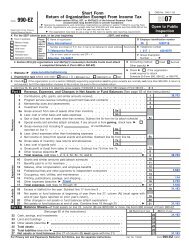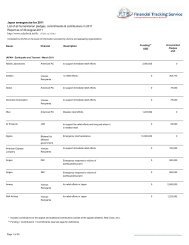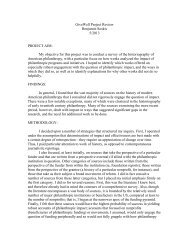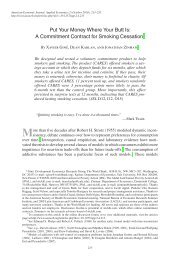Getting In Staying On Moving Up - GiveWell
Getting In Staying On Moving Up - GiveWell
Getting In Staying On Moving Up - GiveWell
Create successful ePaper yourself
Turn your PDF publications into a flip-book with our unique Google optimized e-Paper software.
20 Working Ventures<br />
more work? Did you have any confrontations?<br />
Did they ask you to do things you<br />
didn’t know how to do?”<br />
The career advisor normally does not call<br />
the client’s employer until two or three<br />
work days have passed, mainly so as not to<br />
raise any red flags about the client or the<br />
program. But within a few days, the career<br />
advisor makes an appointment to meet the<br />
employer and visit the workplace, and then<br />
takes the new employee to a “business<br />
lunch,” courtesy of VFI. Some employers<br />
are reluctant to meet, and many will give<br />
the career advisor only a few minutes. But<br />
even so, career advisors find it useful to see<br />
the employer and the workplace firsthand,<br />
to verify what they learn from the client<br />
about the job requirements and the client’s<br />
performance, and at least to leave open the<br />
possibility that the employer will let the<br />
career advisor help if problems arise.<br />
After the introductory meeting, career advisors<br />
normally try to meet with the employer<br />
one more time and then maintain occasional<br />
telephone contact unless the employer<br />
seems to want more. The business lunches<br />
with clients continue for roughly six<br />
months, however, as part of the career advisor’s<br />
regular monitoring. The relationship<br />
between client and advisor varies over time.<br />
During the first week on the job, the client<br />
speaks with the career advisor every day.<br />
For the first few months after that, once a<br />
week is usually enough, and once a month<br />
for the remaining two years. Naturally,<br />
though, if a crisis develops, the contacts<br />
become frequent again.<br />
Dealing with Crises<br />
When they are not about lateness or missed<br />
days, most crises are set off by behavioral<br />
problems in the workplace, typically the<br />
result of a lack of experience or maturity.<br />
<strong>In</strong> those cases, the career advisor tries to<br />
intervene as quickly as possible, often as<br />
mediator between employee and employer.<br />
Sometimes the crisis is touched off by a<br />
problem the career advisor can help solve,<br />
like finding affordable child care. If the situation<br />
does not seem salvageable, the<br />
career advisor may take the client off of the<br />
job and, if the employer agrees, offer<br />
another candidate, just to save the relationship<br />
with the employer and not unduly discourage<br />
the client. About one out of every<br />
eight placements requires some kind of<br />
intervention by the career advisor.<br />
<strong>In</strong> VFI’s management records, clients<br />
remain the responsibility of their career<br />
advisor even when they drop out of the<br />
program. Career advisors will attempt to<br />
find “inactive” clients by mail, phone and<br />
even home visits, sometimes speaking with<br />
other clients in the program who know the<br />
person to find out how to get him or her<br />
involved again. It works surprisingly often;<br />
sometimes clients return to finish the program<br />
after being out for as long as seven<br />
months.

















